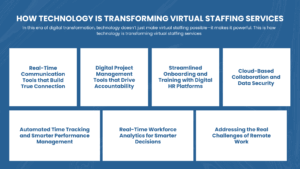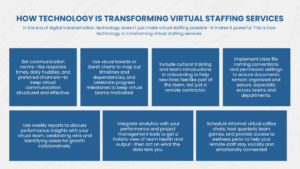
1. Real-Time Communication Tools that Build True Connection
Collaboration is the heartbeat of any high-performing team, and communication tools have become the lifeblood of virtual staffing services. Platforms like Slack, Zoom, and Microsoft Teams provide synchronous and asynchronous communication, allowing virtual employees to share updates, participate in meetings, and stay aligned with company goals—regardless of geography. These tools are now integrated with calendars, task boards, and CRMs—creating an all-in-one digital HQ. They reduce miscommunication, speed up feedback loops, and strengthen relationships between clients and virtual staff. Even more, real-time messaging fosters a culture of transparency and accessibility. Employees feel included and connected, which directly impacts retention and performance. Pro Tip: Set communication norms—like response times, daily huddles, and preferred channels—to keep virtual communication structured and effective.2. Digital Project Management Tools that Drive Accountability
With virtual teams, clarity is king. That’s why businesses relying on virtual staffing services use project management platforms such as Asana, Trello, Monday.com, and ClickUp to track tasks, milestones, and progress in real time. These tools act as a centralized command center for managing responsibilities. Managers can assign tasks, monitor KPIs, set priorities, and automate reminders—all of which help keep the team aligned and on schedule. The visibility these tools provide eliminates bottlenecks and builds a culture of accountability and autonomy. A Capterra study found that companies using PM tools improved productivity by 25% and enhanced on-time delivery by 28%—proving their impact on operations. Pro Tip: Use visual boards or Gantt charts to map out timelines and dependencies, and celebrate progress milestones to keep virtual teams motivated.3. Streamlined Onboarding and Training with Digital HR Platforms
A great onboarding experience leads to higher engagement, and virtual staffing services have mastered the use of digital HR platforms like BambooHR, Gusto, and Trainual to create seamless, scalable onboarding flows. These platforms help employees complete compliance documents, access training modules, and understand company values all in one place. With gamified learning paths, automation, and onboarding checklists, new hires ramp up faster and feel integrated from day one. Pro Tip: Include cultural training and team introductions in onboarding to help new hires feel like part of the team, not just a remote contractor.4. Cloud-Based Collaboration and Data Security
The backbone of modern virtual staffing services is cloud technology. Platforms like Google Workspace, Dropbox, and OneDrive allow for real-time editing, seamless document sharing, and multi-user collaboration from anywhere in the world. But it’s not just about accessibility. These tools now come with robust security features such as end-to-end encryption, multi-factor authentication, and admin controls. This ensures your company’s intellectual property and sensitive data are protected—even in a remote environment. Cloud tools eliminate the version control chaos of emailing documents back and forth, and instead offer live collaboration that accelerates decision-making and execution. Pro Tip: Implement clear file naming conventions and permission settings to ensure documents remain organized and secure, especially across teams and departments.5. Automated Time Tracking and Smarter Performance Management
One of the biggest challenges of remote work is ensuring productivity—without micromanaging. That’s where platforms like Time Doctor, Harvest, and Hubstaff come in. They help virtual staffing services and clients monitor time use, track activity, and generate actionable performance reports. These systems also highlight trends, like when employees are most productive, how long tasks take, and where bottlenecks occur. With this data, you can personalize workflows, recognize top performers, and provide timely feedback. Importantly, these tools shift performance management from reactive to proactive—empowering both employers and virtual staff to optimize how they work. Pro Tip: Use weekly reports to discuss performance insights with your virtual team, celebrating wins and identifying areas for growth collaboratively.6. Real-Time Workforce Analytics for Smarter Decisions
Today’s virtual staffing services rely heavily on analytics to optimize operations. Dashboards powered by workforce analytics tools (e.g., Tableau, Power BI, or even built-in tools in HR platforms) provide visibility into capacity planning, engagement scores, project throughput, and cost efficiency. You can spot when a team member is overworked, forecast hiring needs, or track employee satisfaction through pulse surveys—all in real time. According to Gartner, companies that use real-time workforce analytics are 25% more productive than those that don’t. Data becomes your decision-making compass, allowing for agile pivots and strategic scaling. Pro Tip: Integrate analytics with your performance and project management tools to get a holistic view of team health and output—then act on what the data tells you.7. Addressing the Real Challenges of Remote Work
While virtual staffing services provide flexibility and reach, they must also navigate challenges like reduced interpersonal interaction, slower learning, and potential health implications of remote isolation. A joint study by MIT and UCLA revealed that remote workers were 18% less productive in fully remote setups compared to hybrid models, due to slower feedback loops and less collaboration. Additionally, a UK survey of 5,000 employees found that full-time remote workers faced increased risks of depression and obesity. Pro Tip: Schedule informal virtual coffee chats, host quarterly team games, and provide access to wellness perks to help your remote staff stay socially and emotionally connected.








